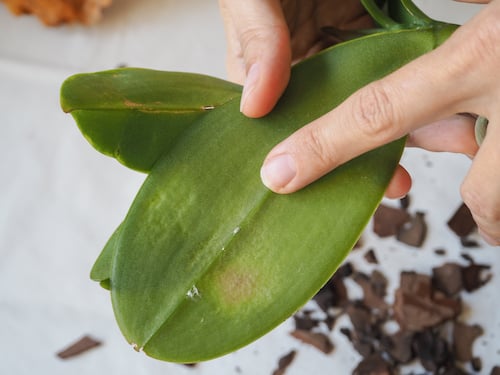
Let’s face it: Bugs will find your orchid, but they don’t have to be the flower’s demise! Once orchid bugs infest the plant, aggressive measures need to be taken to save your orchid collection and even other plants nearby.
It’s important to note, that any Phalaenopsis orchid suffering from a pest invasion should be isolated from other houseplants until it is bug-free.
In this post, we will discuss the 4 most common bugs that can infest your plant, including scale, aphids, mealybugs, and spider mites.
Don’t forget: If you spot any pests on your orchids, be sure to quarantine them in another room until the infestation is gone. Bugs can travel from plant to plant, causing more infested plants and big headaches.

Scale insects attach themselves to the stems and leaves of orchids and other houseplants. Soft-scale insects are white and cottony. Hard-scale insects are small, oval, and flat with a hard brown shell.
When they take over a plant, it will start to look withered and sickly. Leaves will turn yellow and may even drop from the plant.
Newly discovered scale infestations can be addressed by rubbing isopropyl alcohol onto the leaves and stems where the insects are located. You can also use your finger to dislodge and discard the pests. Treatment should be repeated when any new insects hatch. Serious or hard-to-treat scale infestations can be addressed by smothering the insects using a spray bottle filled with neem oil — an insecticide found at most gardening centers.
For the best results, apply insecticides weekly for a month or until you notice the bugs are gone. If nothing seems to be working or the scale bug numbers are increasing, it may be time to part with your plant.

Aphids find their way into almost every garden, and they’re a common houseplant pest, too. They are small, soft-bodied insects that suck fluid out of plants and leave a sticky-sweet sap in their wake. The sap then grows mold that will destroy the orchid. Aphids multiply quickly, so it’s best to catch them early. They love to hide on the underside of leaves.
Aphids can be removed by squirting water on them. Aphid treatment must be repeated every few days for the best results. Insecticidal soap may be required for serious infestations with continued treatment for several weeks following

These predatory mites suck on and kill the cells on the surface of Phalaenopsis orchid leaves. Their damage takes on a silvery color, and if spider mite populations are left undetected, they can cause significant harm to your plant. An obvious sign of spider mites? Like other types of spiders, spider mites will spin silky webs among the leaves they infest.
When spider mites are suspected, use a white cloth to wipe the Phalaenopsis leaf. If the cloth appears to have brown or red streaks on it, then spider mites are present. Spider mites thrive in a hot, dry climate. If spider mites are present, increase the humidity of the orchid plant by wiping it down with water.
Placing the plant in a humidity tray will help to bring the humidity levels up in the growing area. Kill spider mites by mixing a few drops of dishwashing liquid with rubbing alcohol (isopropyl alcohol) and spraying the orchid each week for several weeks to ensure that any new spider mites are killed.

Mealybugs are soft-bodied, oval-shaped, wingless insects that look like white cottony masses on orchid leaves and stems. Found in warmer growing climates, they also live in potting medium or under potting trays. Mealybugs also suck the life out of stems and leaves and leave behind a sticky honeydew which encourages the growth of sooty molds. In small numbers, mealybugs are not a threat to your plant, but larger mealybug infestations are hard to get under control.
These pests can be killed by spraying the entire Phalaenopsis orchid with rubbing alcohol (isopropyl alcohol) because the insects also live in the potting media, the alcohol will need to be drizzled into the pot and sprayed on the outside of the planter. Let stand for five minutes and then rinse all alcohol away with water.
Mealybugs on the orchid may need to be removed with a cotton ball or swab dipped in alcohol. Neem oil and insecticidal soap are also an option for killing this and any other insects that feed on your plants.
It’s a good idea to examine your orchid, especially the underside of leaves, to stop an infestation in its tracks. If you’re unsure if what you’re seeing is a bug, move your orchid to another area just to be safe.
Unfortunately, some infestations may be past the point of saving but try your best! Worst case scenario, you should isolate your plant so you don’t have to risk it spreading to your other plants and if it doesn’t make it, you can treat yourself to a well-deserved new plant!

Copyright Just Add Ice® Orchids 2023